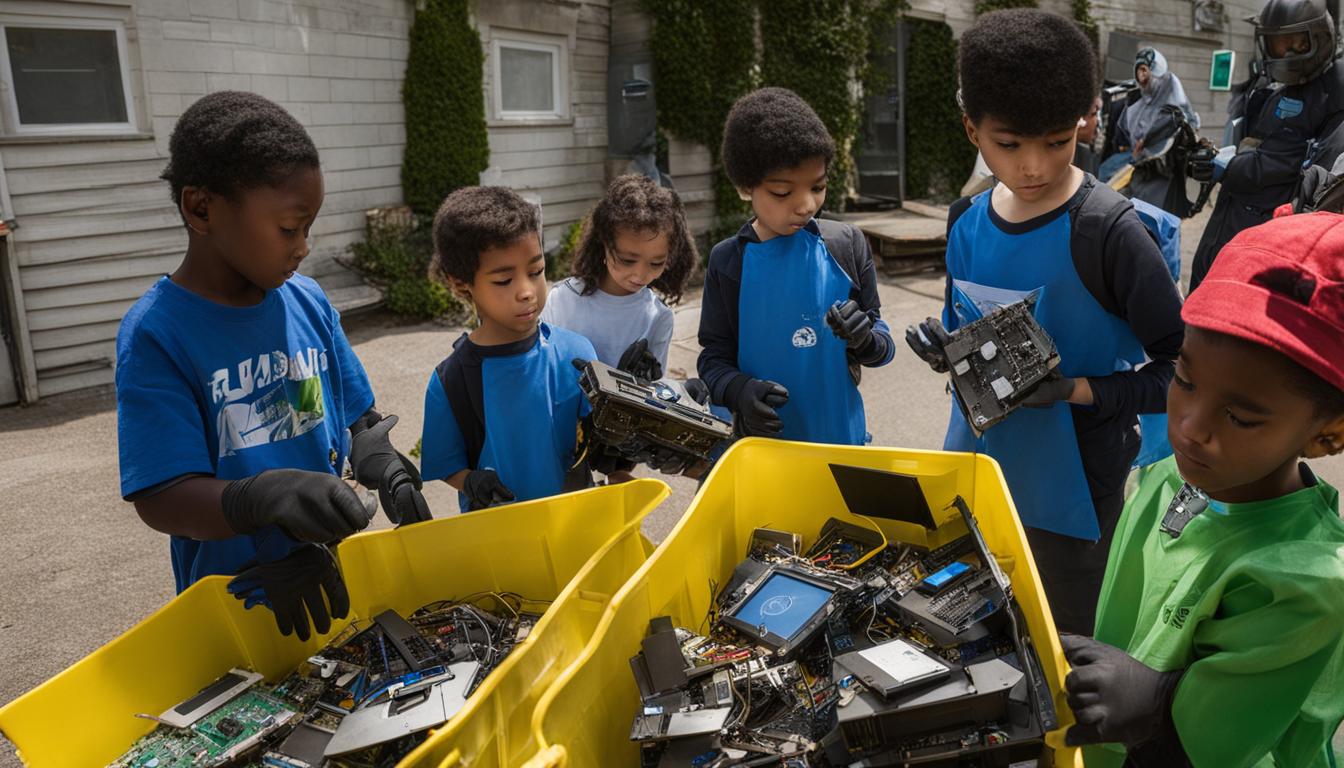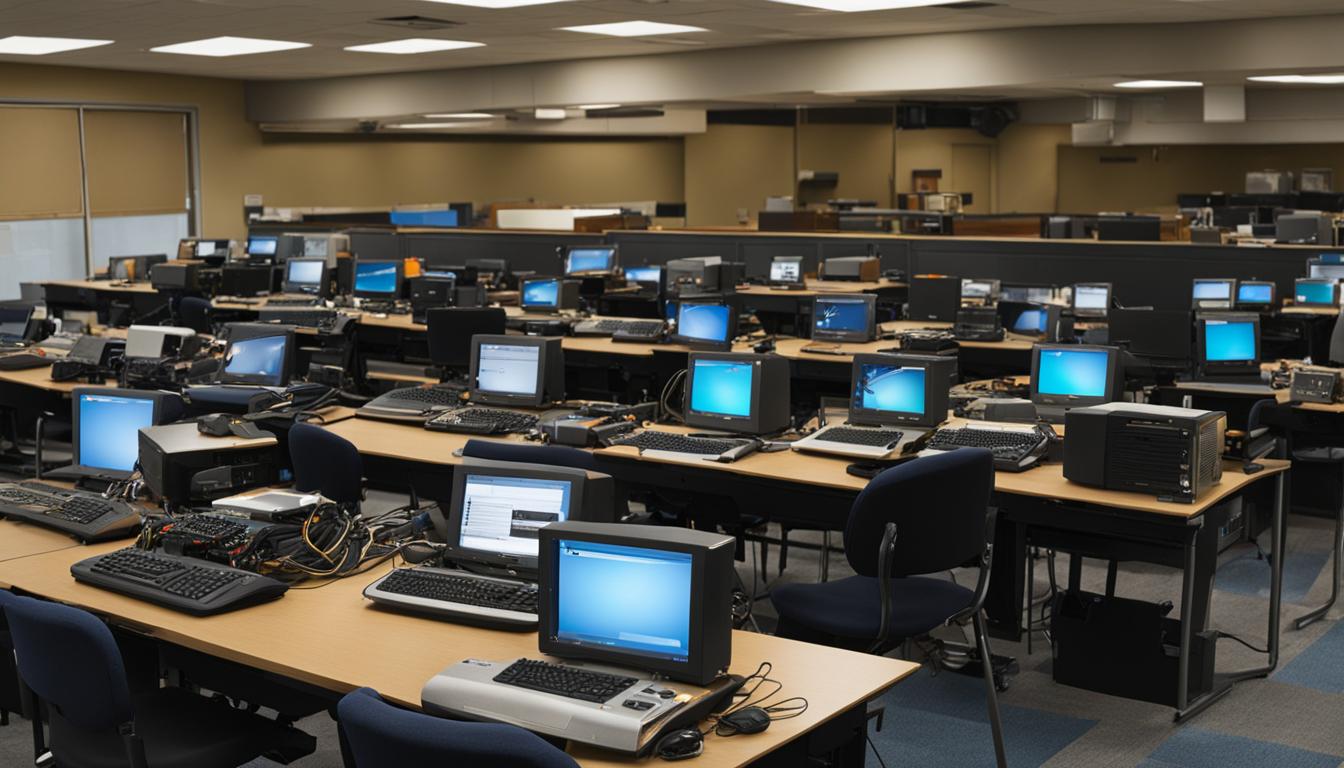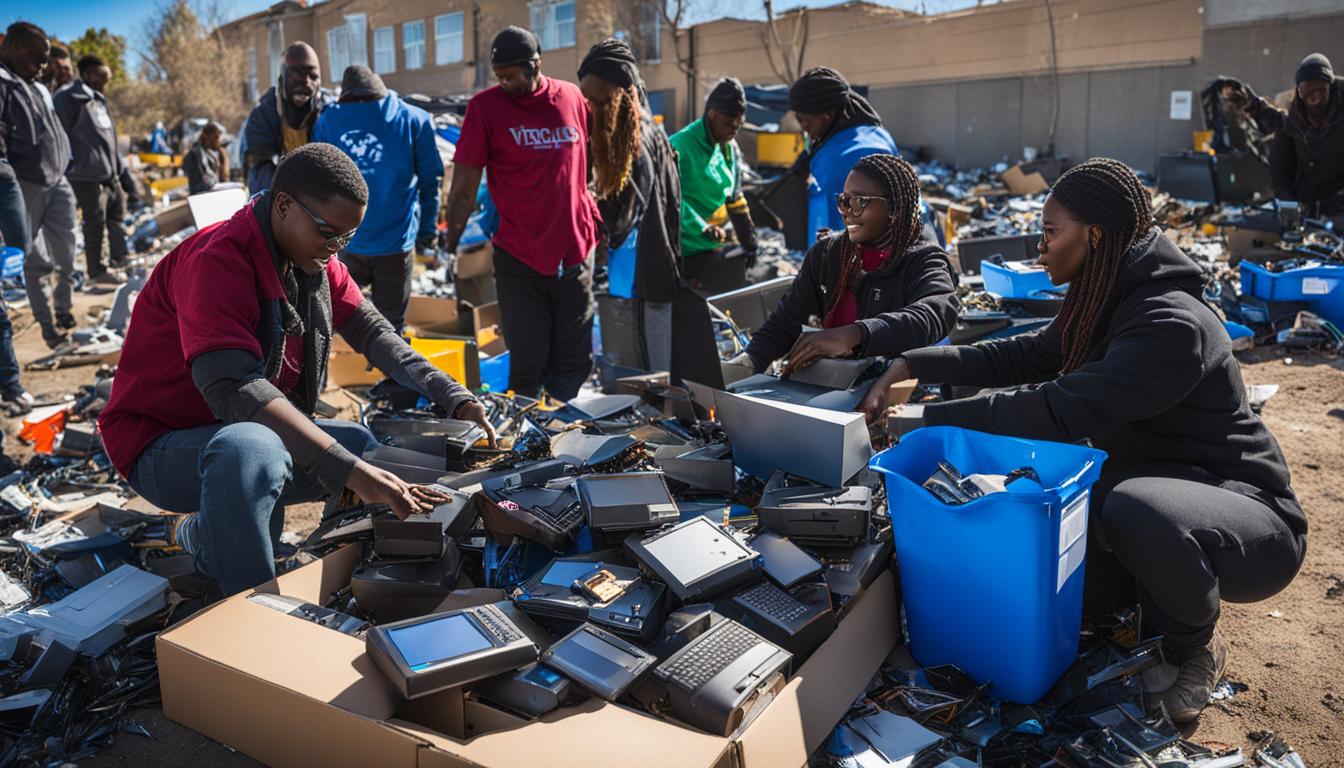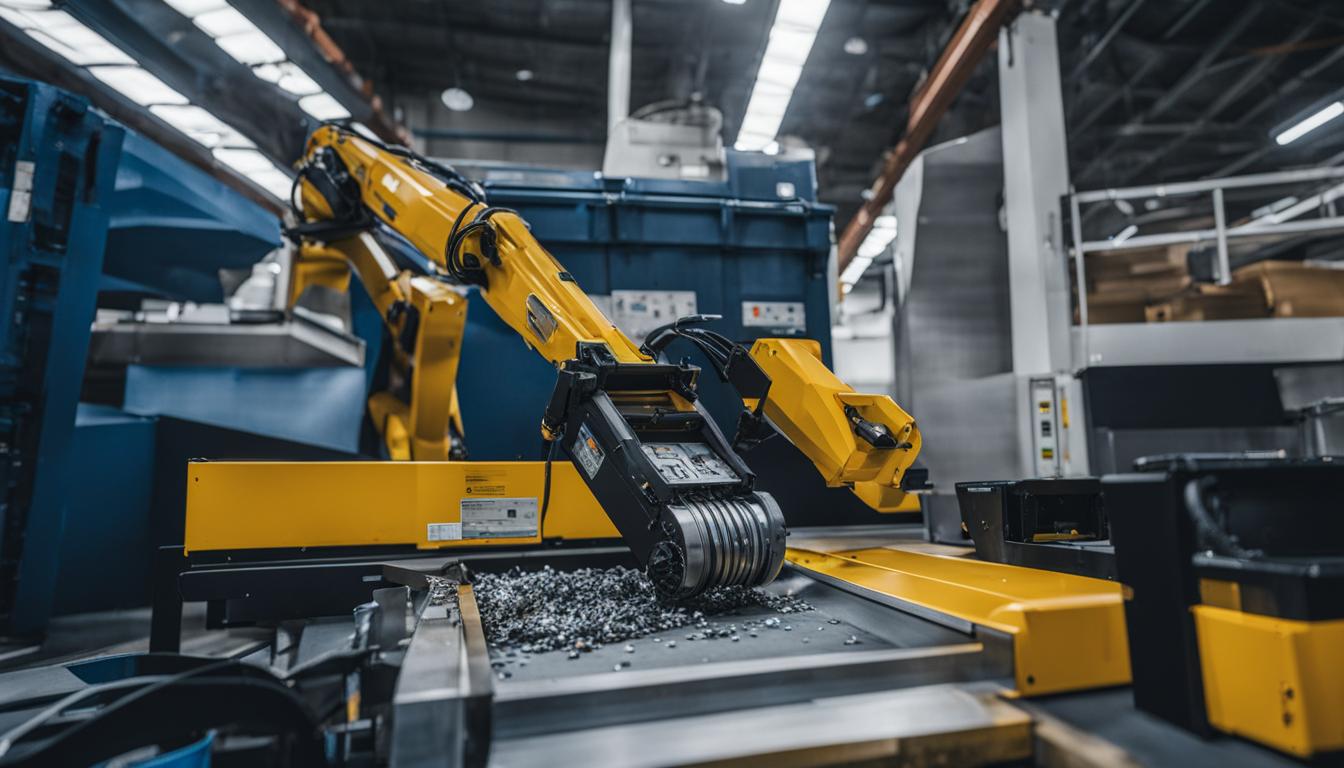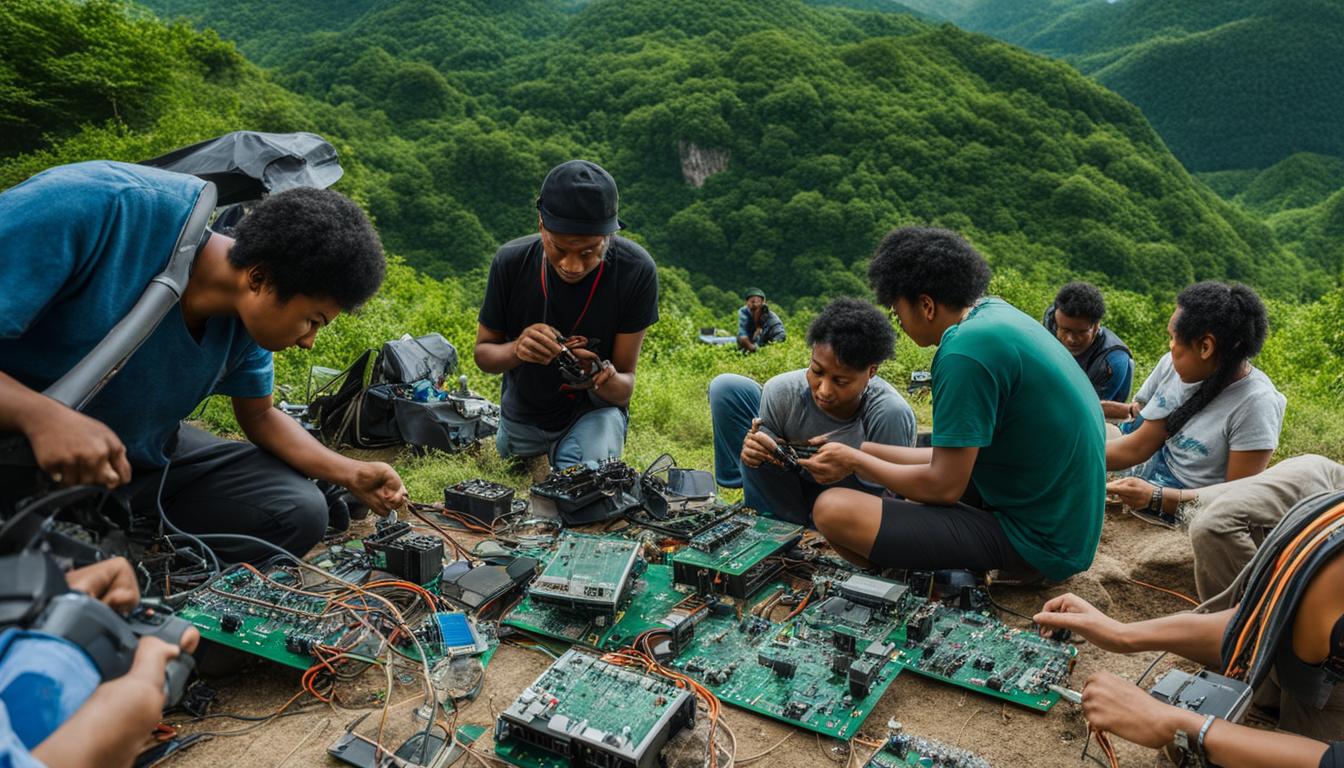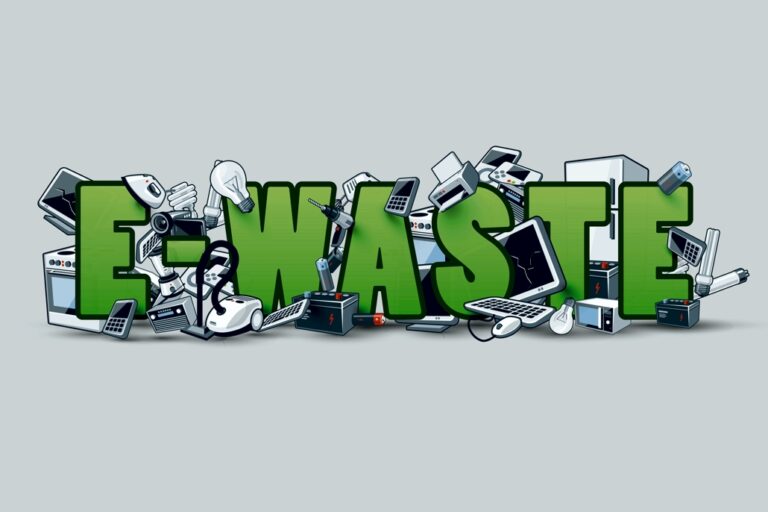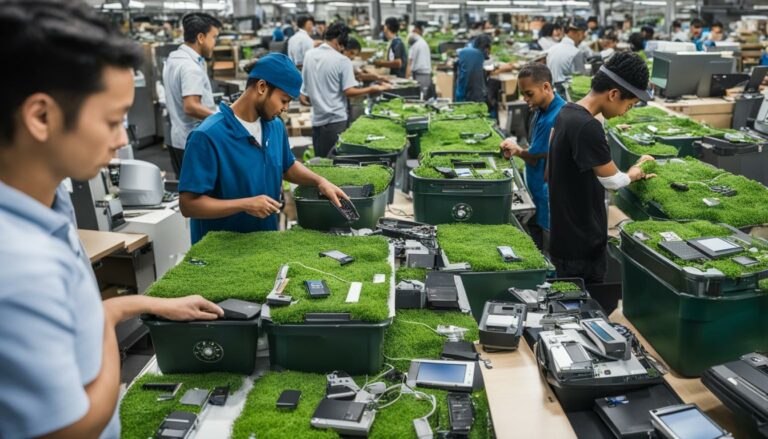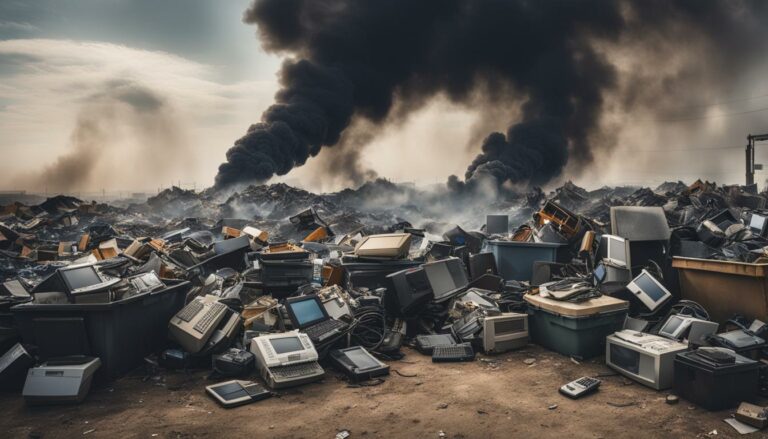Educating the Next Generation on IT Recycling
In today’s digital age, responsible e-waste management and green IT practices are more important than ever. As technology continues to advance at a rapid pace, the disposal of electronic devices has become a pressing environmental concern. That’s why educating the next generation about IT recycling is crucial for a sustainable future.
Many nurseries and primary schools in the UK and internationally have taken initiative in introducing recycling schemes to educate children about responsible e-waste management. These schemes, supported by organizations like Keep Britain Tidy and WRAP, aim to make recycling fun and engaging for children. Colorful and child-friendly bins made from recycled plastic, such as the Smiley Face Bins and Emoji Bins from Leafield, are used to captivate the attention of young minds.
By instilling sustainable habits in children from a young age, we can cultivate a generation that understands the importance of IT recycling. In this article, we will explore the rising issue of e-waste, the role of Gen Z in tackling this problem, and the fun ways to teach kids about recycling. Together, let’s empower our children to become responsible global citizens who actively contribute to the preservation of our planet.
Key Takeaways:
- Educating children about IT recycling is crucial for a sustainable future.
- Many nurseries and primary schools have introduced recycling schemes to teach responsible e-waste management.
- Colorful and child-friendly bins made from recycled plastic make recycling engaging for children.
- Gen Z shows a strong willingness to take action against waste and environmental issues.
- Fun and interactive methods can make recycling education enjoyable for children.
The Rising Issue of E-waste
E-waste is a growing environmental problem worldwide. In the UK alone, over 17.5 million unused phones and tablets are stashed away in homes. Improper disposal of electronic devices can have devastating environmental impacts, including the release of toxic chemicals into the soil and waterways. The UK currently produces more electrical waste per person than any other country except Norway. Without proper recycling and responsible technology disposal practices, this issue will only continue to worsen. It is crucial to educate the next generation about the environmental impact of IT and the importance of responsible e-waste management.
The impact of e-waste on the environment cannot be understated. When electronics end up in landfills, they contribute to the release of hazardous substances such as lead, mercury, and cadmium. These chemicals can contaminate the soil and water, posing serious health risks to humans and wildlife. Additionally, the production of electronic devices requires the extraction of valuable resources, including rare metals like gold and silver, contributing to deforestation and habitat loss.
The UK currently produces more electrical waste per person than any other country except Norway.
To address the rising issue of e-waste, it is essential to implement effective computer waste management and electronic waste recycling systems. This involves establishing proper collection and recycling facilities where individuals can responsibly dispose of their old electronic devices. It also requires educating the public about the importance of recycling and the potential environmental consequences of improper e-waste disposal. By promoting sustainable practices and encouraging individuals to take responsibility for their electronic waste, we can work towards a greener and more sustainable future.
The Role of Gen Z in Tackling E-waste
Gen Z, the generation born between 1997 and 2012, is showing a strong willingness to take action against waste and environmental issues. This generation is more aware of the environmental impact of IT and is actively seeking ways to contribute to responsible e-waste management. However, many young people are still unaware of the recycling facilities available to support their recycling efforts. It is crucial to equip this generation with the knowledge and resources to make a positive impact on e-waste management. By harnessing their enthusiasm and educating them about IT sustainability, we can create a generation of e-waste warriors who actively contribute to solving this pressing issue.
One way to engage Gen Z in the fight against e-waste is by providing them with information on the environmental impact of IT. By understanding the consequences of improper disposal, young people are more likely to take steps to recycle their electronic devices. Additionally, raising awareness about the importance of responsible e-waste management can help Gen Z make informed decisions when it comes to the lifecycle of their gadgets.
To support their recycling efforts, it is essential to make recycling facilities easily accessible to Gen Z. Providing information on local recycling centers and drop-off points can empower young people to dispose of their electronic devices responsibly. Furthermore, education on the proper methods of recycling, including data wiping and safe disposal of batteries, can help Gen Z navigate the recycling process with confidence.
Table: Generation Z’s Attitude Towards IT Sustainability
| Attitude | Percentage of Gen Z |
|---|---|
| Willingness to recycle electronic devices | 87% |
| Awareness of the environmental impact of IT | 92% |
| Knowledge of local recycling facilities | 65% |
| Understanding of proper recycling methods | 79% |
By empowering Gen Z with the necessary tools and information, we can tap into their passion for sustainability and enlist their help in tackling the e-waste problem. Engaging this generation in responsible e-waste management is not only crucial for the environment but also for nurturing a sense of responsibility and activism among young people. Together, we can create a more sustainable future and inspire future generations to continue the fight against e-waste.
Teaching Children the Importance of Recycling
Instilling the habit of recycling in children from a young age is essential for promoting sustainability. By teaching them about computer waste management and e-waste disposal, we can empower them to become responsible stewards of the environment. Recycling education should focus on the pillars of the 3Rs: Reduce, Reuse, and Recycle.
Children should be taught to minimize waste generation by reducing their consumption of single-use items and unnecessary technology gadgets. They can learn the value of reusing objects by repurposing them creatively. For example, old computer parts can be transformed into art or functional items like pen holders. By extending the life of objects, children not only reduce waste but also cultivate resourcefulness and creativity.
| Benefits of Recycling Education for Children | Ways to Teach Children About Recycling |
|---|---|
|
|
Incorporating interactive activities into recycling education can make the learning experience fun and engaging for children. Recycling relays and competitions can encourage friendly competition while teaching the importance of sorting and disposing of waste properly. Crafting with waste materials allows children to unleash their creativity while learning how to transform and repurpose items. Additionally, field trips to recycling facilities provide hands-on learning experiences that demonstrate the journey of recyclable materials and highlight the impact of responsible computer waste management.
Quotes:
“Recycling education for children is crucial for building a sustainable future. By teaching them about computer waste management and sustainable technology practices, we empower them to make a positive impact on the environment.” – Jane Smith, Environmental Educator
Overall, teaching children the importance of recycling is a vital step towards creating a greener and more sustainable future. By incorporating interactive activities, demonstrating practical examples, and emphasizing the value of reducing, reusing, and recycling, we can instill lifelong habits that benefit both the environment and future generations.
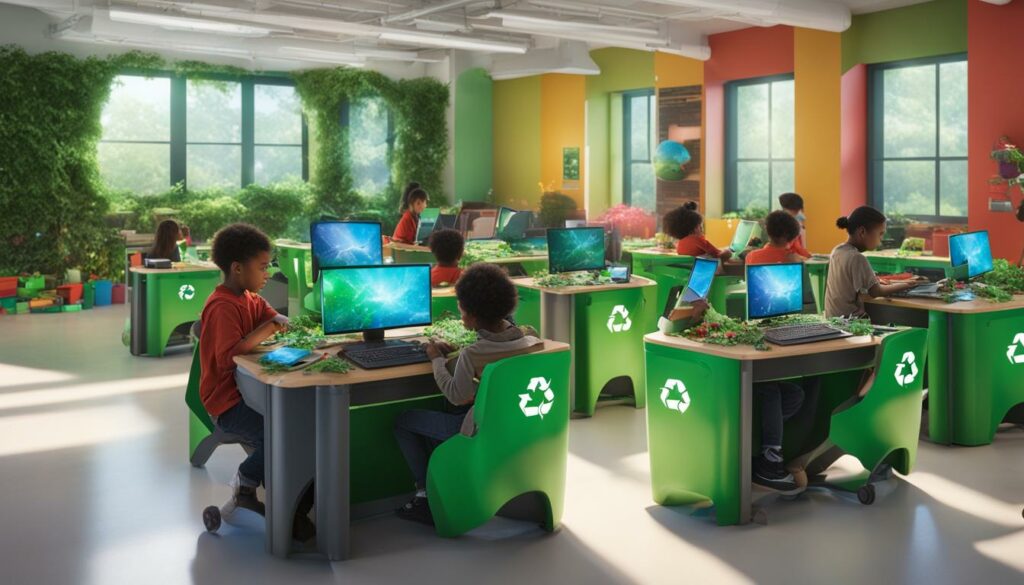
Fun Ways to Teach Kids About Recycling
Teaching children about recycling can be a fun and engaging experience that instills sustainable habits from a young age. By incorporating interactive activities and creative approaches, we can make recycling education enjoyable for kids. Here are some exciting ways to teach children about recycling:
1. Recycling Relays
Organize a recycling relay race where children compete to collect and sort recyclable items. Divide them into teams and provide different bins for paper, plastic, glass, and metal. The team that correctly sorts the most items within a set time wins. This activity not only educates children about recycling but also promotes teamwork and physical activity.
2. Crafting With Waste
Encourage children to get creative by repurposing waste materials to make artwork or useful objects. Provide a variety of recyclable items like cardboard boxes, plastic bottles, and old magazines. Let their imagination run wild as they transform these materials into sculptures, collages, or functional items like pencil holders or bird feeders. This activity not only teaches the importance of recycling but also promotes creativity and resourcefulness.
3. Field Trips to Recycling Facilities
Take children on a field trip to a local recycling facility to show them firsthand how recycling works. Allow them to see the entire process, from collection and sorting to the transformation of materials into new products. This experience helps children understand the impact of their recycling efforts and encourages them to continue recycling at home and in school.
By employing these fun and interactive methods, we can make recycling education an enjoyable and memorable experience for children. By nurturing their understanding of green IT practices, we can empower them to become advocates for responsible recycling and contribute to a sustainable future.
The Role of Recycling at Home
Recycling doesn’t start and end at the school gates – it begins at home. Creating a recycling center in your own household is a simple yet impactful way to teach children about e-waste disposal and computer waste management. By involving children in the process and making it fun, you can instill lifelong sustainable habits.

The Benefits of Recycling at Home
- Teaches children responsibility: By actively involving children in recycling at home, they learn to take responsibility for their actions and understand the impact they can make on the environment.
- Promotes organization: Setting up a recycling center with separate bins for different materials encourages children to organize and sort their waste properly.
- Fosters creativity: Decorating the recycling bins can be a fun activity for children, allowing them to express their creativity while reinforcing the importance of recycling.
- Encourages teamwork: Recycling as a family activity promotes teamwork and cooperation, as everyone works together to reduce waste and protect the planet.
By making recycling a part of daily life at home, you normalize sustainable practices and create a positive impact on the environment. It is crucial to explain to children the significance of identifying recyclable items and the process of separating them for proper disposal.
“Teaching children about recycling at home sets the foundation for responsible e-waste management. By involving them in the process and making it a fun and inclusive activity, we can create a generation that understands the importance of computer waste management and actively contributes to a greener future.” – Sustainability Expert
| Materials | Recycling Bin |
|---|---|
| Paper and Cardboard | Blue Bin |
| Plastic Bottles and Containers | Green Bin |
| Glass Bottles and Jars | Clear Bin |
| Aluminum Cans | Silver Bin |
Creating a recycling center at home and involving children in the process is a small step that can yield significant results in promoting responsible e-waste management. By teaching children to think critically about their consumption habits and the impact of their actions, we can raise a generation that values sustainable practices and actively contributes to a greener future.
The Importance of Reducing and Reusing
Before recycling, it is important to teach children about the significance of reducing and reusing. Encouraging minimalism and questioning the necessity of new items can reduce waste generation. Reusing objects by repurposing them can spark creativity and help children value their belongings. Old clothes can be transformed into cleaning cloths, and leftover food can be stored and repurposed. By emphasizing the importance of reducing and reusing, we can make a substantial impact on e-waste disposal and promote sustainable technology practices.
Introducing the concept of reducing waste is vital in teaching children about responsible e-waste disposal. By encouraging them to think critically about their consumption habits, we can instill a mindset of sustainability. This can be achieved through discussions about the environmental impact of excessive waste and the finite resources of our planet. Children can be encouraged to embrace minimalism by only acquiring items they truly need, reducing the accumulation of unnecessary possessions that may ultimately become e-waste.
Reusing items is another important aspect of sustainable technology practices. By encouraging children to repurpose items instead of discarding them, we can foster creativity and resourcefulness. For example, old cardboard boxes can be transformed into storage containers or imaginative play structures. By teaching children to see the value in reusing objects, we can help them develop a mindset that promotes resource conservation and reduces the amount of e-waste that ends up in landfills.
| E-waste Recycling Benefits | Sustainable Technology Practices |
|---|---|
| Reduces environmental pollution | Promotes resource conservation |
| Conserves valuable resources | Minimizes landfill waste |
| Prevents health hazards caused by toxic materials | Fosters creativity and resourcefulness |
Teaching children the importance of reducing and reusing not only benefits the environment but also helps them develop crucial life skills. By instilling sustainable habits at a young age, we can empower the next generation to actively contribute to the reduction of e-waste and promote green IT practices. Through education and modeling sustainable behavior, we can create a future where responsible technology use and e-waste disposal are the norm.
Conclusion
Teaching children about IT recycling and instilling sustainable habits at a young age is crucial for the future of our planet. By educating them about the environmental impact of IT and the importance of responsible e-waste management, we can create a generation of individuals who actively contribute to solving this pressing issue.
Through fun and interactive methods, such as recycling relays and crafting with waste, we can make recycling education engaging and memorable for children. By working together as a society and equipping the next generation with the knowledge and tools they need, we can pave the way for a sustainable future.
By instilling sustainable habits in children from a young age, we can ensure that they grow up with a deep understanding of the importance of responsible computer waste management. This knowledge will empower them to make informed choices and take actions that minimize waste generation, extend the life of objects through repurposing, and recycle electronic devices properly.
Teaching children about the environmental impact of IT and the importance of responsible e-waste management is not only a responsibility but also an opportunity to shape a better future. Let us guide and inspire the next generation to become advocates for sustainable practices and create a world where IT recycling is a common and valued habit.
FAQ
What are some organizations that provide guidance for setting up recycling schemes in nurseries and primary schools?
Keep Britain Tidy and WRAP are two organizations that offer guidance and support for setting up recycling schemes in educational institutions.
What are some child-friendly recycling bins available for schools?
Leafield offers a range of colorful and child-friendly bins made from recycled plastic, such as the Smiley Face Bins and Emoji Bins.
Why is it important to teach children about IT recycling from a young age?
By teaching children about IT recycling at a young age, we can instill sustainable habits that will benefit the environment in the long run.
What are the environmental impacts of improper e-waste disposal?
Improper disposal of electronic devices can lead to the release of toxic chemicals into the soil and waterways, causing environmental damage.
What generation shows a strong willingness to take action against waste and environmental issues?
Gen Z, born between 1997 and 2012, shows a strong willingness to take action against waste and environmental issues.
What can parents do to promote recycling at home?
Parents can set up a recycling center at home with separate bins for different materials and involve their children in the recycling process.
How can recycling education be made fun and engaging for children?
Recycling education can be made fun and engaging for children through activities such as recycling relays, crafting with waste, and field trips to recycling facilities.
Why is reducing and reusing important in e-waste management?
Emphasizing the importance of reducing and reusing can significantly reduce waste generation and promote sustainable technology practices.

